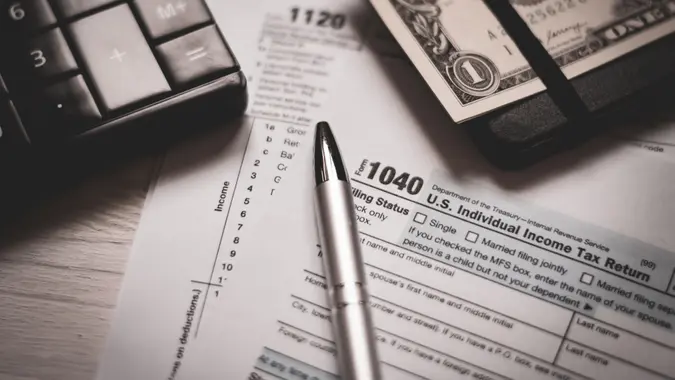3 Signs You’re Not Taking Advantage of Tax-Deferred Savings

Commitment to Our Readers
GOBankingRates' editorial team is committed to bringing you unbiased reviews and information. We use data-driven methodologies to evaluate financial products and services - our reviews and ratings are not influenced by advertisers. You can read more about our editorial guidelines and our products and services review methodology.

20 Years
Helping You Live Richer

Reviewed
by Experts

Trusted by
Millions of Readers
Tax-advantaged accounts for retirement and healthcare savings let you delay paying income taxes on contributions and any earnings until it’s time to make withdrawals. Such accounts could save you significantly if you can move income to a year when you’re in a lower tax bracket. To ensure you benefit and understand the rules, recognize these three signs that you’re not taking advantage of tax-deferred savings options.
1. You’re Not Contributing to Your Employer’s Retirement Plan
If your workplace has a traditional 401(k), 403(b) or similar retirement plan and you’re not contributing, you’re missing out in two ways. First, you could be deferring income taxes on up to $23,000 of your pay in 2024 ($30,500 if you’re at least 50) when you put that cash in the account. Second, your employer might offer a match with free money that boosts your retirement savings.
You can ask your employer about the plan options and matches. If eligible, get started contributing as much as you can. You’ll pay taxes when you withdraw the funds someday. Just watch out for potential early withdrawal penalties.
2. You Haven’t Opened a Traditional IRA
Whether you’re self-employed or you’ve already maxed out your employer’s plan, you shouldn’t ignore another tax-deferred way to save for retirement. A traditional IRA, which you open through an investment brokerage, could let you save up to $7,000 ($8,000 if you’re at least 50) in pre-tax earnings. This is a good retirement account for beginners who value flexibility.
You must meet IRS requirements to deduct traditional IRA contributions, though. The deductible amounts depend on which filing status you use, how much your modified adjusted gross income is and whether you or your spouse has an employer retirement plan. Like with a traditional employer plan, you’ll need to pay income taxes upon withdrawal and consider early withdrawal penalties.
3. While Eligible, You Have No Health Savings Account
You’re missing out on tax savings if you have a qualifying health insurance plan but lack a health savings account. Designed to cover your out-of-pocket healthcare expenses, this account supports up to $4,150 (for an individual) or $8,300 (for a family) in pre-tax contributions made on your own or from your paychecks in 2024. You can add $1,000 to your limit if you’re at least 55. Interest accumulates tax-free.
In addition to having these contributions deducted from the current year’s income for taxes, you can make tax-free withdrawals for your eligible healthcare costs. However, you would pay income taxes and penalties upon withdrawals used for other expenses unless you’re at least 65, at which time the penalty ends.
More From GOBankingRates
 Written by
Written by  Edited by
Edited by 

























